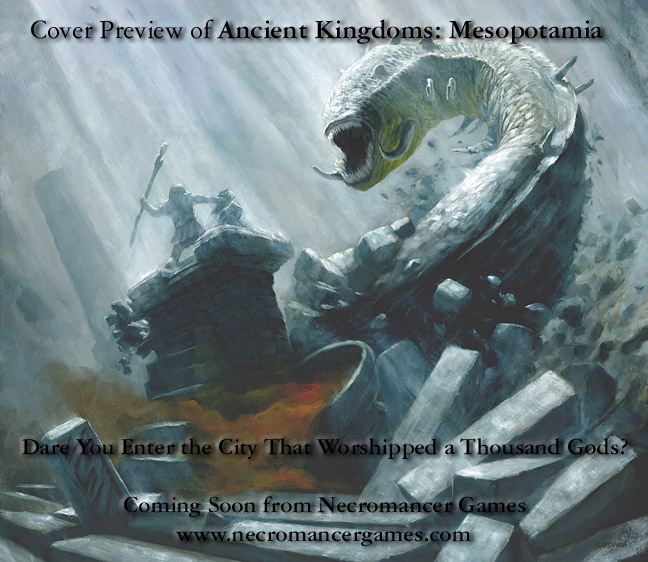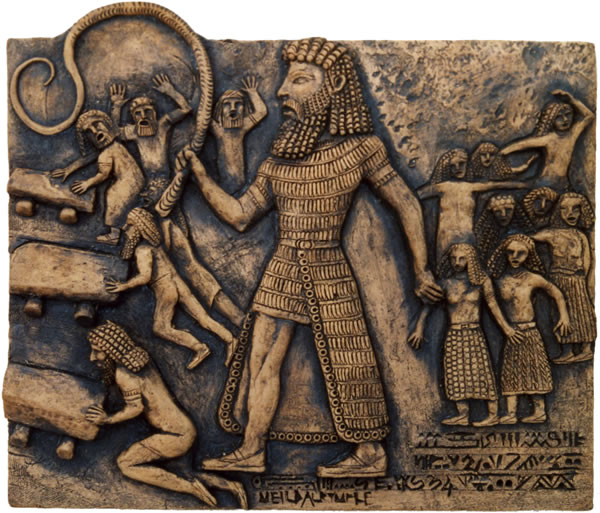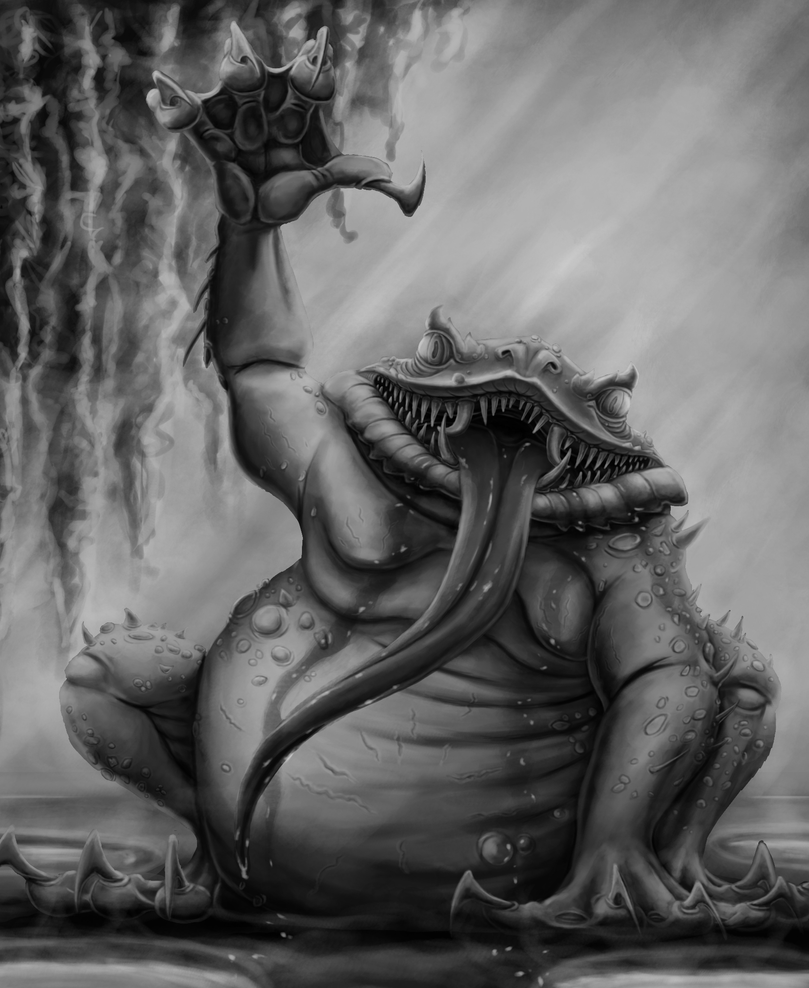
Necromancer Games put out a number of dungeon crawls (The Tomb of Abysthor, The Vault of Larin Karr, The Crucible of Freya, Rappan Athuk) that seem to be reasonably well-regarded by people who know that they exist. (Their back catalog also contains a 2001 adventure written by none other than a fledgling Mike Mearls, but we will try to not hold that against them too much.) The colon in this book's title suggests it may have been intended to be the first of an Ancient Kingdoms series. If so, these plans were for naught, because no other Ancient Kingdoms books ever was ever published. Necromancer Games continued trundling on until 2012, when it was acquired by Frog God Games, a company run by one of the guys who initially ran Necromancer Games. So it's more likely that this book just sold like shit.
Necromancer Games products are advertised as having "third edition rules, first edition feel". This might be sufficient to send many Denners heading to the hills immediately, and not without good justification. But it's not as bad as it could be. For products like this, it means that the adventure locations are not meant to be encountered in a specifc manner, and, as such, little attempt has been made to ensure that opponents are encountered in a level-appropriate order. Done well, this can make the game world feel much more real and less centered around the PCs. Done poorly, it can lead to MCs slapping you in the face with their giant CR 20 cocks while you're still dicking around in the low levels. Hopefully AK:M is more of the former.
Ancient Kingdoms: Mesopotamia hails from the long-ago days of 2004. D&D's revived success had probably peaked by this point, but WotC had not begun spewing forth the stream of shovelware (mixed with those neat sporadic successes) that would characterize mid- and late-era 3.5. This book claims to be compatible with 3.5, but it contains reference to 3.0 artifacts like the Scry skill. So it was presumably written before 3.5 came out and then hastily updated. The statblocks, as in many other early 3E products, are terrible. Another Necromancer Games adventure contains as its final boss a lich Sorcerer 12 / Druid 6. Clearly a challenge worthy of a 20th level party.
As a final note, this book was written by a dude named Morten Braten. That would be the most metal name I've heard all day, if not for the list of his playtesters, which includes Roald Aronsson, Yngve Danielsen, Trond Oliversen, Egil Rekdal, and Kjartan Sletvold.
Chapter One: Mythic Mesopotamia
If you ask yourself the question "Why set my D&D game in fantasy Mesopotamia?", these opening paragraphs present a decent answer. You do it so that you can tell hardcore sword & sorcery stories. I am totally on board for that. I mean, if the phrase "despotic priest-kings" doesn't get you psyched for some gaming, then what are you even doing with your life? Unfortunately, these paragraphs make it sadly ambiguous whether just the "bearded" descriptor applies to both women and men, or just men. I'm hoping that all beardedness will be distributed without prejudice.The glittering fires of civilization beckon the weary desert traveller, who drives his heavily laden camel-train through the desert sands towards the city-states dotted like pearls on a string along the twin rivers Euphrates and Tigris. Here, despotic priest-kings rule from ziggurats that stretch skywards to the starry realm of the gods, while robed priests heap sacrifice upon the earthly altars of brazen and obscene idols.
Bearded men and women from a hundred nations throng the crowded streets of gardened Babylon, Nineveh with its libraries, age-old Uruk, and glittering Nippur. Woollen-robed stargazers guard ancient wisdom and science written on cuneiform tablets in their forbidding towers of mud-brick, while on the skull-strewn battlefields between the city-states, bronze swords clash against wooden shields and mighty warriors crash their chariots into the serried ranks of enemy spearmen.
This is the splendor that is Mythic Mesopotamia.
You'll note from this introduction that this book does not create its own pseudo-Mesopotamia setting, it just uses the actual place names. In the WHRP OSSR, Frank complained that it's kind of lazy to make a secondary world that defaults to real-world names for some of its countries. That may or may not be true. But even if it is, it's less applicable here because of distance. We have all been inundated with stories and games that take place in medieval England, France, Japan, ancient Rome, whatever, or that take place in thinly-veiled pastiches of those locations. Saying, "Okay, this world has a place called Albion" might actually convey more preconceptions than you want to your players. So you throw some syllables together and make up a word like Westeros, or Ferelden, or Nilfgaard, or the Nansurium or whatever and describe your word as "like X, but...". And everyone wins.
We don't quite have that surfeit of information with Mesopotamia. Like, maybe you got assigned part of Gilgamesh for high school English class, maybe you've read Snow Crash or Vellum, but, other than that, what do "Ur", "Uruk", "Enlil", and "Inanna" mean to you? You probably have some vague associations with those words, but that's it. So by using actual Mesopotamian names, this book is able to draw on that murky historical resonance without tying itself down to excessive specificities.
For this chapter, the book sez it will use "Mesopotamian" and "Sumerian" interchangeably. I cannot tell if this is just supposed to simplify things for the reader, or if it is suggestive of lazy editing.
We get a map, and it's basically this one,
Next up there is a high-level overview of Morten Braten's Mesopotamia. It's a mix of wikipedia facts and decently gameable descriptions. So more or less what you would expect. It includes a few paragraphs about the cities of Asshur, Babylon, Eridu, Kish, Kutha, and Nippur. These are the only cities described in any detail in the entire book. So this is kind of an odd subset to focus on. You get their populations, but you don't care. More interesting are the bits that follow.
Babylon is devoted to Tiamat, and it has "mighty blue gates guarded by dragons and winged bulls". Kutha is "dominated by huge mortuary temples aboveground, and endless black halls and maggot-ridden mausoleums underground". Eridu was founded by Deep Ones, and now it is a realm of "sorcerers and demon-summoners of the blackest sort" who live in "great red towers". There's a very Zothique feel to this, which I dig. You can whip out your copy of The Dark Eidolon and just make Namirrha an NPC in Eridu or Kutha.
None of this is sufficient to run an adventure (or even a session) in any of these places, but it hopefully gets the imagination going.
There's an equally brief description of the neighboring lands. These include some mountains where barbarians live and some marshes (that do not appear on the map at all). The mountains feature a location called the "frigid plateau of Ong", which I assume is meant to be a Lovecraft reference. If it is, I am not sure why the author didn't just call it Leng.
We get a bit more than two pages of history. It's a mix of background information from millenia before that campaign starts that you don't care about and some interesting or useful details. (Apparently, Dagon is responsible for more or less all of human culture.) Ultimately, the section is too short to have that much chaff.
Every old-school product needs a reminder that alignment has always been incredibly stupid, and AK:M fulfills that amply with Hammurabi. We have the usual D&D thing where Hammurabi's Code is described as being good because it is divine in origin (which ignores the countless neutral and evil gods of D&D-land). The Code is described as a lawful good relic (okay) that eventually drove Hammurabi insane (what). It led him to pass laws under which all but the most pious of citizens risked death for "crimes both real and imagined". Which is obviously what any relic of Law and Good would compel its wielder to do.
The main issue with this section is that it starts with creation myths and ends with Alexander the Great. Nowhere does it stop and say "yeah, this is where your campaign should start" or even "this is when the other setting bits are most relevant". You can cross-reference this section with the city and deity descriptions and get something of an idea, but that is not something you should have to do with a published product.
There's an equally brief setup of Mesopotamian society: social classes, laws, festivals, architecture, that sort of thing. Today, you could get everything here with a quick trip to wikipedia, but presumably you could not back in 2003 or 2004.
Sometimes you get neat bits like this:
and other times you get rambling diatribes about how Mesopotamians measured time and distance.Under Sumerian laws, everyone is not equal under the law. It is a far more serious crime to harm a noble or priest than a slave or poor person; however, this works both ways, as a noble who commits a crime is more severely punished than someone from the lower classes that commits the same crime.
Mesopotamia is meant to be a pre-Bronze Age setting, so the default material for weapons and armor is copper. Weapons made of bronze or iron get a bonus to attack and damage that stacks with magical enhancements. There's a list of what weapons and armor you are allowed to use. That would be fine for a historical setting, but this is pretty clearly not that. Chainmail and chain shirts are forbidden, as is all heavy armor. There are no longswords or greatswords, but there is the sickle sword, which is identical to a longsword except that it's better at disarming people. The author could have just made up items that match up with the mechanics of the banned equipment, and everyone would have been happier.
The chapter ends with a short (4/5 of a page) dictionary of Sumerian terms, and an even shorter (1/5 of that same page) list of Sumerian names. (Sadly, Gilgamesh is not one of the suggested names.) It probably would have been more useful to make the page space ratio more like 60-40 or something, but whatever. Now you know that the Sumerian word for vampire is "akhkharu".
Up next: Racism and Prestige Classes



